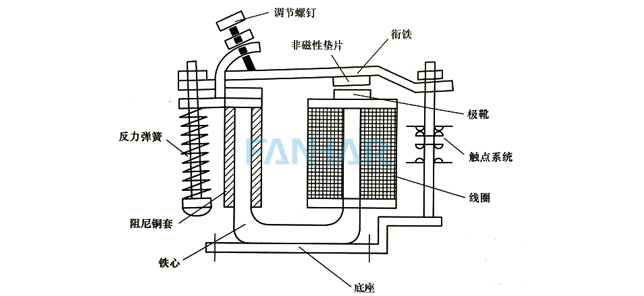Current relays, intermediate relays and voltage relays are all electromagnetic relays and are widely used in industrial production. Fanhua will introduce you to their basic knowledge and structure from three types of electromagnetic relays:
From the original work, the basic structure and working principle of the electromagnetic relay are similar to the contactor, which is composed of the iron core, the coil, the return spring, the armature and the contact. Since the electromagnetic relay is used for auxiliary circuits, its on and off current is small, so it is not equipped with an arc extinguishing device. The electromagnetic system of electromagnetic relay has two types: direct-acting and snap-fit. The electromagnetic mechanism of the AC relay has a U-shaped snap-fit type and an E-shaped direct-acting type. The electromagnetic mechanism of the DC relay is a U-shaped snap fit, and its structure is as follows (electromagnetic relay structure diagram):
 (electromagnetic relay structure diagram)
(electromagnetic relay structure diagram)
The electromagnetic system core and iron yoke of the electromagnetic relay shown in the figure are a unified body, so as to reduce the non-working air gap. The pole piece is a ring and covers the end of the iron core. The armature is made into a rotatable plate-like structure. When not energized, the armature of the electromagnetic relay is opened by the action of the reaction force spring, and the contact system is reset. After the power is turned on, the electromagnetic attraction force makes the armature to be attracted to the iron core, which drives the contact system to open and close.
Structure and working principle of current relay
The coil of the current relay is connected in series in the circuit, the wire diameter of the coil is thick, the number of turns is small, and the impedance is also small. The current relay turns on or off the circuit according to the magnitude of the current in the first circuit, so as to reflect the change of the current in the circuit. In addition to current-type protection, current relays are often used for current-based control. According to the size of the pull-in current, current relays are divided into overcurrent relays and undercurrent relays.
The overcurrent relay does not act when the circuit is working normally, and when the current exceeds a certain setting value, the armature produces a pull-in action, which drives the contact action. Usually, the pickup current setting range of the AC overcurrent relay is usually 1.1-4 times the rated current, and the pickup current setting range of the DC overcurrent relay is usually 0.7-3.5 times the rated current. Since the overcurrent relay is released under normal conditions (that is, the current is near the rated value), it will only act when an overcurrent occurs in the circuit.
Intermediate relay structure and working principle
The intermediate relay is essentially a voltage relay, which acts as an intermediate element for converting control signals. The input signal of the intermediate relay is the power-on or power-off signal of the coil, and the output signal is the action of the contact. The number of contacts is large, and the contact capacity is also large. The intermediate relay is used in the circuit as an intermediate conversion (transfer, amplify, shunt, invert the signal).
Structure and working principle of voltage relay
The action of the contact of the voltage relay is related to the action voltage of the coil. The relay is called a voltage relay. When used, the coil of the voltage relay is connected in parallel with the load. The coil has a large number of turns, a thin wire diameter and a large impedance. According to the type of current in the coil, it can be divided into AC voltage relay and DC voltage relay. According to the size of the pull-in voltage, the voltage relay is divided into three types: over-voltage, under-voltage and zero-voltage relay. In low-voltage control circuits, under-voltage and zero-voltage relays are used more. The undervoltage relay pulls in when the circuit voltage is normal, and releases and returns when an undervoltage (0.4-0.7Ue) occurs.
Electromagnetic relays are divided into DC relays and AC relays according to the type and type of electromagnetic coil current. Electromagnetic relays are divided into current relays, voltage relays, and intermediate relays according to the connection method of coils in the circuit. DC relays and AC relays can be divided into current relays, intermediate relays and voltage relays according to their connection methods in the circuit.
Now you should have a more comprehensive understanding of electromagnetic relays. If you have any questions, you can call our consulting service hotline: 0573-83872666. Fanhar will make every effort to answer your questions and learn together! ! !
